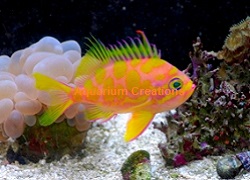Aquarium Conditioned
Japanese Borbonius Anthias
Odontanthias borbonius

Identification:
The Borbonius Anthias(Odontanthias borbonius) is a rare deep water anthias also known as the Spotted Anthias, Checked Anthias, or Blotchy Anthias. One of the true beauties of the sea, being a deep water anthias is why it is much harder to obtain. This is an expensive anthias. It's a real beauty to behold and, given the right environment and husbandry, it is not exceptionally difficult to keep. They are most commonly collected at depths of more than 200 foot deep. A peaceful fish it will not bother other fish, inverts of coral found in reef tanks. This makes them a great addition for reef tanks. Since the Borbonius Anthias are deep water anthias, they typically do not do well with bright lights and higher temperatures sometimes found in some reef tanks. With a pink background covered with blotchey golden markings they make for an unforgetable addition to a saltwater aquarium. Because anthias such as the Borbonius Anthias require more feedings than many other species of marine aquarium fishes, it is generally advisable to provide hefty filtration including an excellent protein skimmer. Keeping the water quality high and stable will go a long way to reducing stress.
Tank Recommendations:
The Borbonius Anthias can be the crown to the reef aquarium, but to have success the aquarium needs to be large, and the deeper the better. Since it originates from deep waters, the Borbonius Anthias prefers to occupy the lower regions of the aquarium. It must have plenty of liverock to swim through and hide in when it feels the need.
Food and diet:
Like other anthias they benefit from several small feedings throughout the day rather than one large feeding. The best feeding for anthias will come from a healthy microinvertebrate population in your aquarium with a constant supply of copepods and amphipods available for food. Having a refugium attached to your aquarium makes the proper supply of food available any time through the steady supply of live food sure to keep any planktivore content. What should you be feeding your anthias? You have to add meaty foods (finely shaved seafood, frozen Cyclops, fish eggs and carnivore foods) at least three times a day. If you do not feed the Borbonius Anthias enough food, it will become more and more emaciated and will gradually perish.
Level of Care:
Moderate
Acclimaton Time:
4+ hours
Reef Compatibility
: Excellent
Approximate Purchase Size:
Small: 1" to 1-3/4"; Medium: 1-3/4" to 2-1/2"; Large: 2-1/2" to 3-1/2"
|
Small$749.99
Medium $789.99
Large $859.99
|
|

